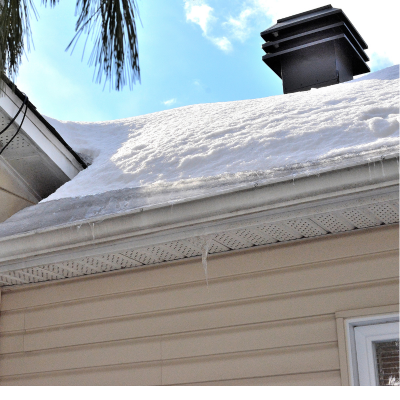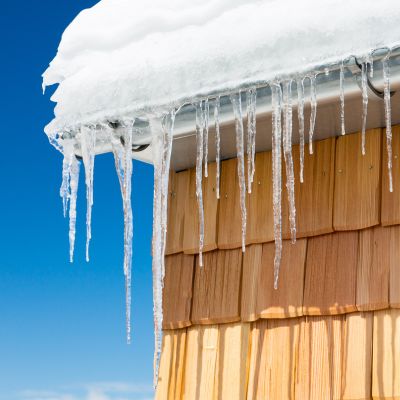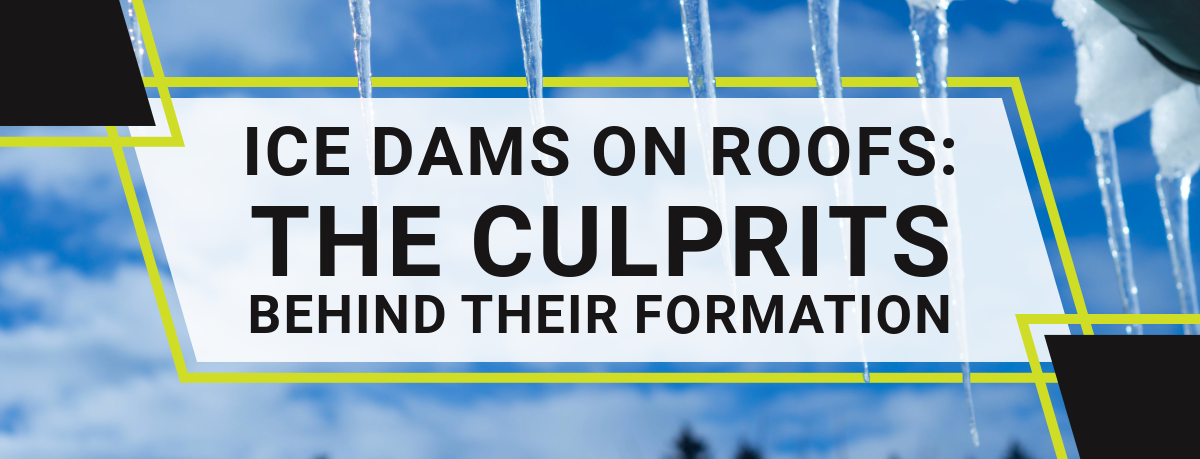Ice dams. Just the thought of them sends shivers down the spine of some homeowners. Others don’t understand how they impact their home. Misinformation keeps homeowners from knowing the facts about ice dams on roofs. How can an attentive homeowner cut through the nonsense?
How Do Ice Dams Form On Roofs?

Generally, Ice dams occur when accumulated snow melts, flows down the sloped roof toward the eaves, and refreezes without exiting the roof. The ice dam prevents additional snowmelt from leaving the roof. Instead, the snowmelt pools and adds to the ice, creating an ice dam.
Fluctuating outdoor temperatures and excess heat escape from the roof, primarily from the attic, contribute significantly to the development of ice dams. Ultimately, unequal surface temperatures on the roof play a major role in how ice dams form.
What Damage Can Be Caused By Ice Dams On Roofs?
Gutter Problems
Because gutters are adjacent to ice dams, they become incredibly susceptible to damage. Ultimately, ice dams can weigh on gutters and tear them away from the roof.
Moisture Intrusion
Ice dams can cause moisture to penetrate the roof and enter the home. They block snowmelt from reaching the roof’s edge or gutters, forming leaks.
Mold And Mildew
When moisture enters spaces with minimal or no air circulation, it may become trapped. Consequently, mold and mildew have a prime environment for breeding.
Structural Issues
Roof sag. Roof collapse. Rotted roof decking and framing. Ice dams can advance the weakening of a home’s structural integrity. Accumulating snow weighs on the roof. Excess water enters the house.
Ways To Eliminate Ice Dams On Roofs
Hire A Roofing Professional To Break Up Ice Dam
Entering a roof on a ladder in the middle of winter is a surefire way to face an accident – maybe severe injury or death. Every year, many homeowners suffer calamitous misfortune from a fall off a ladder or the roof while trying to remove an ice dam. Involving a trained professional with the right tools and equipment avoids this unnecessary risk.

Safely Remove Accumulating Snow From The Roof
As snow piles up on the roof, its weight places significant pressure on the structural integrity of a home. Occasionally, pulling off some of the snow relieves the roof of this added stress and reduces the likelihood of ice dams forming. Using a long-handled roof rake from the ground level is a relatively safe way for the homeowner to remove excess snow.
Keep Gutters And Downspouts Clean Of Debris
In warmer months, dirt and debris accumulate in the gutters and downspouts. With fall, leaves drop from trees and further clog them. Often, homeowners fail to clean the gutters and downspouts with the onset of winter. Unfortunately, clogs contribute significantly to ice dam formation since meltwater cannot flow through gutters and downspouts efficiently.
Prevent Ice Dams From Forming On Roofs
Ensure Your Home Has Proper Ventilation
A home with an efficient ventilation system ensures that cold air circulates under the entire roof. Ice dams will form when different regions of the roof possess disparate temperatures. Typically, elevated portions of the roof are warmer than the areas closer to the eaves. A ridge vent and continuous soffit vents can prevent this unequal gradient.
Install A Water And Ice Shield Under Your Roof
One of the most effective ways to protect your roof and prevent ice dams from forming is to install a water and ice shield under the shingles along the roof’s edge, and adjacent to chimneys, skylights, vents, and ducts. Many homeowners also add heat coils along the eaves to prevent snow from refreezing.
Make Certain That Exhaust Ducts Exit Correctly
Exhaust ducts are a source of heat loss from the home. Exhaust ducts from bathrooms, kitchens, and laundry rooms vent heat and moisture out of the house. Ideally, they should exit through the walls rather than the roof. If they must go through the roof, make sure they do not penetrate through the soffits. Ice dam formation tends to occur adjacent to soffits.
Seal Air Leaks At Roof Penetration Locations
Seal areas where protrusions through the roof, such as electrical cables, vent pipes, chimneys, solar panels, skylights, exhaust ducts, occur. Any area that cuts through the roofing material is susceptible to heat loss from the house. Sealing those areas and ensuring sufficient flashing where necessary prevents heat escape.
Involving A Roofing Contractor For Professional Guidance
If you own a home in Connecticut or the Springfield, Massachusetts areas, you understand the hazards of winter weather. Your roof protects your home from dangerous snow, wind, and ice. However, if you incur roofing problems, contact Rhino-Back Roofing immediately. We have the knowledge and experience to assist you with any roofing needs, no matter what season. To set up a free inspection, contact us today.

